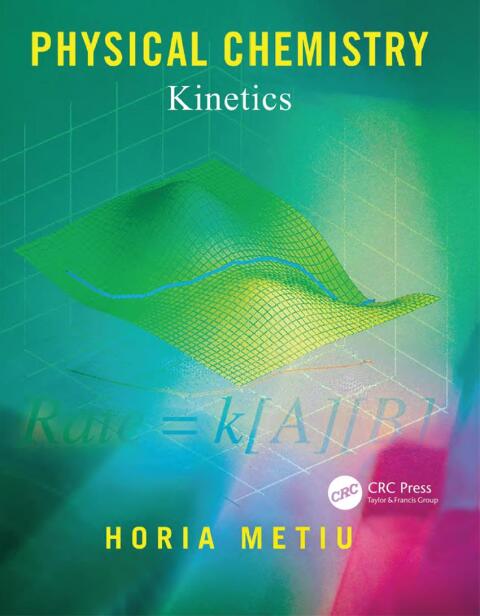Description
Efnisyfirlit
- Cover
- Half Title
- Title Page
- Copyright Page
- Table of Contents
- Preface
- How to use the workbooks, exercises, and problems
- Chapter 1 Generalities about the rates of chemical reactions
- Introduction
- Chemical kinetics: what is it?
- The rate of a chemical reaction
- How to define the rate of a reaction
- The extent of reaction
- The evolution of the extent of reaction
- The reaction rate
- Mass conservation in a chemical reaction
- Example: rate of decomposition of uranyl nitrate
- The general scheme of kinetics
- Let us add some theory: a phenomenological approach
- Testing the equation and determining the rate constant
- Supplement 1.1 Concentration
- Supplement 1.2 A summary of what you need to know about differential equations
- A differential equation has an infinite number of solutions
- The initial condition
- How to solve differential equations: a practical guide
- Systems of differential equations
- Chapter 2 Irreversible first-order reactions
- Introduction
- What is an irreversible first-order reaction?
- Unimolecular irreversible reactions
- The rate equation
- Not all unimolecular reactions have a first-order rate
- Solution of the rate equation
- The extent of reaction
- Solving the rate equation to calculate η(t)
- The concentrations
- Test whether Eq. 2.10 fits the data and determine the constant k(T,p)
- A crude fitting method
- The least-squares method for fitting the data
- Chapter 3 The temperature dependence of the rate constant: the Arrhenius formula
- Introduction
- The Arrhenius formula
- How to determine the parameters in the Arrhenius formula
- How to determine k0, E, and n
- How to determine the constants in the Arrhenius equation: the data
- A graphic method for using the Arrhenius formula
- A crude determination of k0 and E in the Arrhenius formula
- The determination of k0 and E by least-squares fitting
- The activation energy
- Determination of the Arrhenius parameters: a more realistic example
- Fitting the data to determine k0 and E
- How do we use these results?
- The decay rate
- Where do these equations come from?
- Why the rate law is dA/dt = –kA?
- Why the Arrhenius law?
- Chapter 4 Irreversible second-order reactions
- Introduction
- The rate equation for an irreversible, bimolecular reaction
- The rate equation for the reaction A + B → C + D
- The rate equation for the reaction 2A → C + D
- The rate equation for the reaction A + B → C + D in terms of the extent of reaction
- The dependence of η(t) on time
- The evolution of the concentrations
- How to use these kinetic equations in practice
- An example: the problem and the data
- An example: setting up the equations
- An example: numerical analysis of the kinetics
- What controls the decay time
- How to analyze kinetic data for second-order reactions
- An example of analysis
- Method I. Calculating k for each data point
- Method II. Using a least-squares fitting
- Chapter 5 Reversible first-order reactions
- Introduction
- The rate equation and its solution
- The rate equation for concentration
- The evolution of the concentrations
- The change of the extent of reaction and concentration: an example
- Understanding the numerical results in the example
- The connection to thermodynamic equilibrium
- Equilibrium concentration by taking the long time limit in the kinetic theory
- Data analysis: an example
- The conversion of 4-hydroxybutanoic acid to its lactone
- The equations used in analysis
- A method of analysis
- Chapter 6 Reversible second-order reactions
- Introduction
- The rate equations
- The equilibrium conditions
- Mass conservation
- The rate equations in terms of the extent of reaction
- A general equation for the rate of change of η(t)
- The solution of the general rate equation for η(t)
- The solution provided by Mathematica
- Solving the differential equation for η(t) by using the methods learned in calculus
- Calculate η(t) for the four types of reaction
- The use of these equations
- Analysis of the reaction 2HI ⇌ H2 + I2
- A summary of the equations needed for analysis
- Using the equilibrium information
- Fitting the data to find kb
- How to use the results of this analysis
- Chapter 7 Coupled reactions
- Introduction
- First-order irreversible parallel reactions
- The rate equations
- Independent variables: the extents of the reactions
- The change of concentration: mass conservation
- The rate equations in terms of η1 and η2
- Solving the rate equations for η1(t) and η2(t)
- First-order irreversible consecutive reactions
- The rate equations
- Mass conservation
- The rate equations for η1 and η2
- Solving the rate equations to obtain η1(t) and η2(t)
- The evolution of the concentrations
- The analysis of the results
- The steady-state approximation
- Why this is called the steady-state approximation
- Testing how well the approximation works
- Chapter 8 An example of a complex reaction: chain reactions
- Introduction
- The correct rate equation
- The reaction mechanism: chain reactions
- Another chain reaction: nuclear reactors and nuclear bombs
- The rate equations for the reactions involved in the mechanism
- The rate of change of [HBr]
- The rate of change of [Br]
- The net rate of change for HBr
- Using the five rate equations
- The temperature dependence
- Chapter 9 Enzyme kinetics
- Introduction
- The Michaelis-Menten mechanism: exact numerical solution
- The rate equations
- The extents of reaction
- Mass conservation
- The rate equations for η1(t) and η2(t)
- The solution of the rate equations
- The Michaelis–Menten mechanism: the steady-state approximation
- The differential equation for R(t)
- The differential equation for the evolution of P(t)
- Practical use of the steady-state approximation to determine Km and k2E(0)
- The evolution of the concentrations in the steady-state approximation
- The evolution of R(t)
- The evolution of P(t) in the steady-state approximation
- The concentration of the complex and of the enzyme in the steady-state approximation
- The Michaelis-Menten mechanism: how good is the steady-state approximation?
- Further reading
- Index







Reviews
There are no reviews yet.